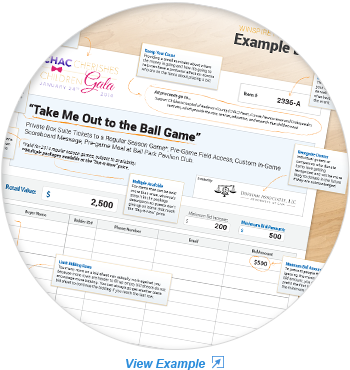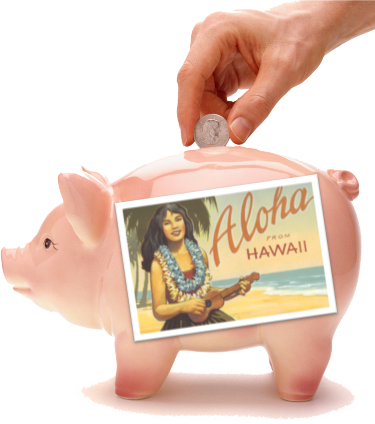Including a few consignment auction items—like jewelry, sports memorabilia and travel packages—in your auction is an easy, no-risk opportunity to rake in thousands for your cause.
How it works: a company lends you an item to include in your auction with no upfront cost. If it sells, you purchase the item using a portion of the proceeds. The remaining difference is your profit.
Since consignment auction items come with a base price for the Nonprofit, you’ll want to determine a “reserve price,” or the minimum price at which you’d be willing to sell the package, beforehand. We typically recommend a reserve price of at least 20% above the Nonprofit cost.
So how do you get bids to that reserve price?
Here are a couple different approaches to setting profitable minimum bids on consignment auction items.
Live Auction
The buzzing social atmosphere of a live auction is perfect for selling unique travel Experiences, and there’s several ways to set opening bids that reach your reserve price. What you choose can depend on the style of your auctioneer.
We recommend hiring a fundraising auctioneer because these professionals know how to capitalize on momentum, emotions and excitement to raise bids. After all, you’ve spent months planning the annual gala and procuring great items, so having an experienced auctioneer makes the most of your efforts.
Option 1: At the reserve price
Starting bidding at 20% over the package price right off the bat guarantees a decent return no matter how many people bid.
For example, one of our most popular packages is Napa Backroads & Railways. The Nonprofit Price is $3100, so a 20% markup means setting a reserve price of $3720. If the item successfully sells for the reserve price or more, you’ve netted at least $620 for your organization. So you can start bidding at $3720, letting guests know this is the minimum price at which the item can be sold.
Option 2: Below the reserve price
With the help of an engaging auctioneer, you can try starting a bit below the reserve price. (We recommend starting at least at the cost of the package.) This strategy is most helpful when you’re confident the package will sell. Starting low generates bidding momentum and engages more guests, which is great for selling the same package multiple times.
No matter what minimum bid strategy you choose, it’s critical to discuss the price of consignment items and your desired reserve price with your auctioneer. You’ll need to work together to rehearse a bidding strategy and establish how much you want to make per consignment item.
Let’s say bidding is slow. Your auctioneer can be up front with your guests about the costs of consignment, and they might say something like: “Ladies and gentlemen, we have a minimum opening bid on this unbelievable vacation package because it’s been consigned by Winspire. No sale occurs until we reach a reserve of $3,700… Do I hear $3,100?”

Another possibility: Going back to the Napa example, let’s say a bidding war ignites between 3 bidders. They’ve stopped just short of the reserve price of $3720, with the final bidder at $3600. Here, it would likely be worth it for your auctioneer to offer the package to all 3 bidders for $3600 each. This would net $500 per person, making you $1500 off one item—nearly $900 more than if you’d sold just one trip at the initial reserve price you’d set.
This is just one example of the kind of creativity and quick thinking your auctioneer can offer to maximize revenue per item.
If underwritten: No minimum bid
If you’ve gotten a consignment item underwritten (paid for by an individual or business), there’s no need to share the cost or set a minimum opening bid.
Why not? In a charity event setting, the collective goal is to raise money for a good cause. So, the actual value or price of the item can have very little to do with how much people are willing to spend. Live auctions are emotionally driven, and all of a sudden, knowing 100% of the proceeds go to your charity makes it more valuable to your guests.
So if you don’t need to share a minimum reserve price, leave it open-ended. Who knows how far the bidding will go!
Silent auction
Since silent auctions don’t have an auctioneer to guide bidding, we recommend setting the opening bid at your reserve price. This guarantees a significant return on your investment regardless of how many bids it attracts.

Like minimum bids, we typically recommend a Buy-it-Now price of at least 20% above the Nonprofit price to secure a profit—but the thrill of a charity auction often allows items to go for much more than their face value. So you can adjust this figure based on your audience’s spending potential.
A note on prices of featured items
The opening bids for your featured items like travel Experiences may be significantly higher than most items in your auction, but this can actually work in your favor in two ways:
1. Gets people spending
Travel packages are not your basic gift certificate or dinner for two. These big-ticket items bring a “wow” factor to your event and create an atmosphere of spending that drives up bidding overall.
2. Redirects travel budgets
A huge benefit of consignment travel in particular is the opportunity to dip into donors’ travel budgets. Donors have separate pockets for both philanthropic and travel spending—in fact, the vast majority of Winspire’s winning bidders set aside $4,000 or more each year for multiple annual trips. So offering high quality trips at a higher price point naturally distinguishes items meant for travel budgets from the rest of your donated items meant for philanthropic spending.
Check out the top 5 reasons nonprofits avoid using consignment.
For example, if a $2,500 travel package wasn’t offered, would each of those donors have spent their $3,750 on something else that was donated? Not unless there was an item of equal or greater value – and even then, there’s no guarantee they would have won the bidding and gotten the chance to spend at your event.
Why not take advantage of your donors’ interest in travel by offering no-risk consignment travel packages that can be sold multiple times?
{{cta(‘222323c1-4c45-44f5-92d9-92afd8782c22′,’justifycenter’)}}



